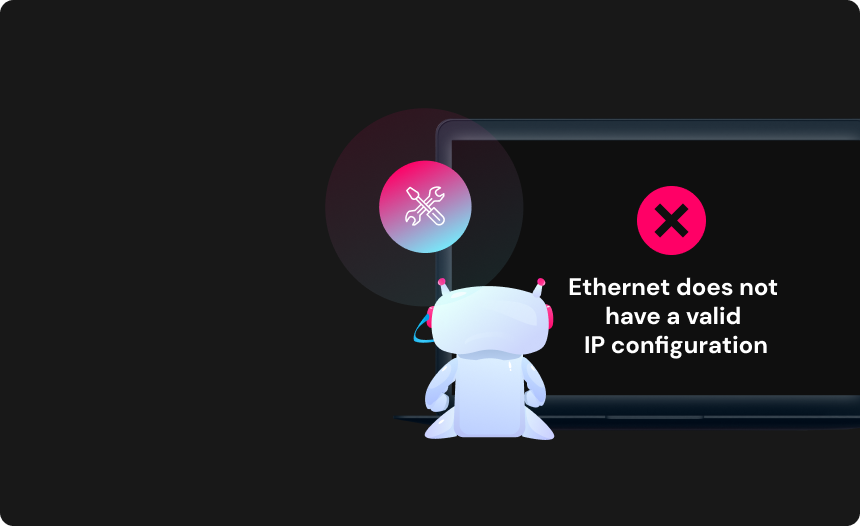How to fix the “Ethernet does not have a valid IP configuration” error

The error message “Ethernet does not have a valid IP configuration” indicates that your ethernet connection is not receiving a valid IP address via DHCP.
The error message “Ethernet Doesn’t Have A Valid IP Configuration” is a standard error message when troubleshooting network connectivity issues on Windows systems. It reveals that the network adapter connected to the Ethernet interface cannot receive a valid IP address, disrupting Internet and local network access.
This error is often caused by DHCP server issues prohibiting the network adapter from receiving the correct IP configuration. As a result, the impacted device is unable to establish a steady network connection, limiting productivity and access to online resources.
To resolve the “Ethernet Doesn’t Have A Valid IP Configuration” error, it’s critical to identify and address the root causes. Let’s go over how to identify the problem and solve it.
What does the “Ethernet does not have a valid IP configuration” error mean?
First, let’s discuss what this error is all about. The error message “Ethernet does not have a valid IP configuration” indicates that your computer is having problems talking with the Ethernet network to which it is connected. It is specific to Windows and can happen on any operating system version.
To better understand, let’s define an Ethernet network. An Ethernet network is a sort of local area network (LAN) that links devices to the Internet or among themselves. This connection is typically created via a wired connection to a modem or router, such as an Ethernet cable.
The basis of all this is that you need an IP configuration. A proper IP configuration is the foundation of a reliable Internet connection. Assume you’re attempting to send a package to a friend without a valid address. Of course, the package will never reach its intended destination.
Similarly, without a correct IP configuration, your computer will be unable to communicate with the Ethernet network or connect to the Internet. This could be due to various factors, including wrong network settings, outdated drivers, or hardware issues.

What are some common causes of the error?
Let’s gain a better understanding of the causes so you can address and resolve the difficulties more efficiently. Here are a few common causes:
Incorrect network settings
When network settings are misconfigured, such as utilizing the incorrect IP address or subnet mask, it can prevent your device from receiving a proper IP configuration.
Faulty Ethernet cable or port
A faulty Ethernet cable or port is one that has been damaged or misconnected. It may disrupt the connection and prevent your device from receiving a legitimate IP address.
DHCP server issues
Your network’s DHCP servers are having troubles or are not performing correctly. Your device may not be able to receive a valid IP address.
Outdated or incompatible network drivers
If your network drivers are outdated or incompatible, they cause compatibility issues and interfere with your device’s ability to establish the proper IP configuration.
How to fix the “Ethernet does not have a valid IP configuration” error
There are several ways to fix this error. Let’s go over them one by one.
Restart your router
Before we get complex, let’s start with the easiest solution. In general, we rarely restart our routers, so this may be the fix you need. Think of it as a siesta for your Internet, waking it up renewed after a short rest. Unplug your modem or router, count to ten, then plug it back in. It’s quick and easy, so give it a try before moving on to more sophisticated fixes.
Restarting your computer is also a good idea – Navigate to the Windows menu or click the Windows button on your keyboard. Hit the Power button, then select the “Restart” option.
Configure your IP / Network adapter settings
Checking your network and IP settings are correct might solve the issue. Follow these steps:
- Right-click the network icon in the taskbar, then select “Network & Internet” settings.
- Click on “Change adapter settings.”
- Right-click your Ethernet connection and choose “Properties.”
- Choose “Internet Protocol Version 4 (TCP / IPv4)” and then click on “Properties.”
- Ensure the settings are set to obtain an IP address and a DNS server address automatically.
- If these options are already selected, try using the details below.
- Enter the IP address and DNS address assigned by your Internet service provider.
- Click “OK” to save your changes.
Update your network drivers
Out-of-date or incompatible network drivers might cause the “Ethernet doesn’t have a valid IP configuration” problem. To update your network drivers, take these steps:
- Press the Windows key + X together, then select “Device Manager” from the menu.
- Now Click on the “Network adapters” category to enlarge it.
- Then, choose “Ethernet adapter” and right-click it. Select “Update Driver.”
- Select the option to seek updated driver software automatically.
- If any updates are available, install them according to the directions on the screen.
- Restart your computer once the driver update is completed.

Clear DNS cache
To resolve the issue, you may need to erase your DNS cache. Take these steps:
- Launch the Command Prompt as an admin by typing “cmd” into the Windows search box, then right-click on “Command Prompt” and select “Run as administrator.”
- Type ipconfig/flushdns into the Command Prompt window and hit “Enter.”
- After the task has finished, restart your computer. This clears your DNS cache.

Disable and re-enable the Ethernet connection
This can reset the network settings and resolve the issue.
- Right-click the Network icon in the taskbar and choose “Network & Sharing Center.”
- Select “Change Adapter Settings.”
- To turn off an Ethernet connection, right-click it and select “Disable.”
- Wait a few seconds, then right-click on the same connection again.
- Select “Enable.”
Troubleshoot Windows
Windows is designed to detect connectivity faults and provide remedies for various problems. Running the Windows Network Troubleshooter is worth attempting, even if it does not always work.
- Open the Settings menu.
- Go to “Network and Internet,” then “Status.”
- Scroll down to the “Network Troubleshooter” and follow the directions.
Error no more!
Hopefully, with one of these solutions, you have fixed the problem and no longer see the error message. Be sure to troubleshoot Windows if everything else fails; your device should tell you how to fix the error.
Protect Your Privacy
with Urban VPN
Download Urban VPN to enjoy complete online security and privacy while hiding IP address.
Free Download





